ECU MAZDA MODEL 3 HATCHBACK 2021 User Guide
[x] Cancel search | Manufacturer: MAZDA, Model Year: 2021, Model line: MODEL 3 HATCHBACK, Model: MAZDA MODEL 3 HATCHBACK 2021Pages: 612, PDF Size: 89.06 MB
Page 47 of 612
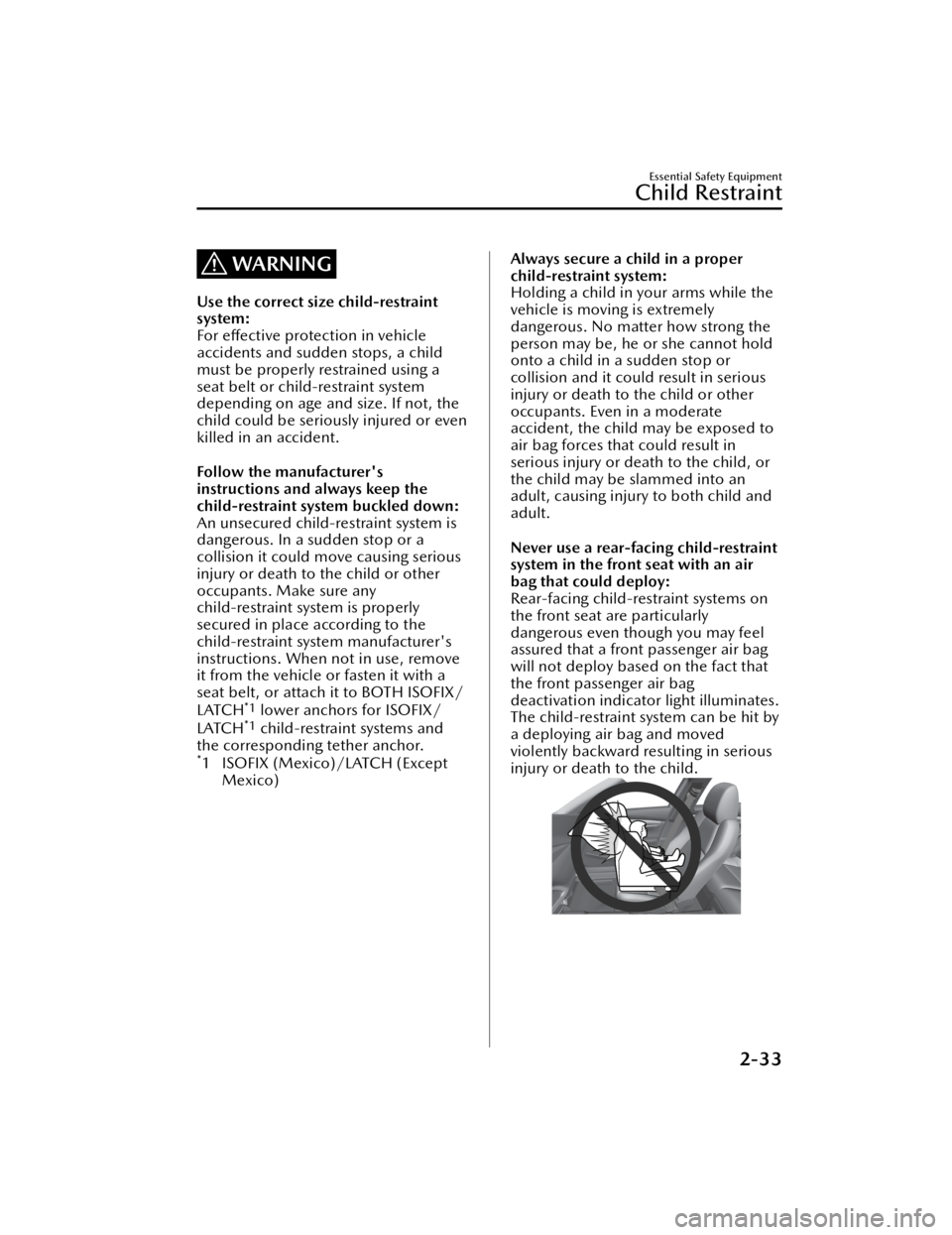
WARNING
Use the correct size child-restraint
system:
For eff ective protection in vehicle
accidents and sudden stops, a child
must be properly restrained using a
seat belt or child-restraint system
depending on age and size. If not, the
child could be seriously injured or even
killed in an accident.
Follow the manufacturer's
instructions and always keep the
child-restraint system buckled down:
An unsecured child-restraint system is
dangerous. In a sudden stop or a
collision it could move causing serious
injury or death to the child or other
occupants. Make sure any
child-restraint system is properly
secured in place according to the
child-restraint system manufacturer's
instructions. When not in use, remove
it from the vehicle or fasten it with a
seat belt, or attach it to BOTH ISOFIX/
LATCH
*1 lower anchors for ISOFIX/
LATCH*1 child-restraint systems and
the corresponding tether anchor.
*1 ISOFIX (Mexico)/LATCH (Except Mexico)
Always secure a child in a proper
child-restraint system:
Holding a child in your arms while the
vehicle is moving is extremely
dangerous. No matter how strong the
person may be, he or she cannot hold
onto a child in a sudden stop or
collision and it could result in serious
injury or death to the child or other
occupants. Even in a moderate
accident, the child may be exposed to
air bag forces that could result in
serious injury or death to the child, or
the child may be slammed into an
adult, causing injury to both child and
adult.
Never use a rear-facing child-restraint
system in the front seat with an air
bag that could deploy:
Rear-facing child-restraint systems on
the front seat are particularly
dangerous even though you may feel
assured that a front passenger air bag
will not deploy based on the fact that
the front passenger air bag
deactivation indicator light illuminates.
The child-restraint system can be hit by
a deploying air bag and moved
violently backward resulting in serious
injury or death to the child.
Essential Safety Equipment
Child Restraint
2-33
Mazda3_8JM2-EA -20H_Edition1_new 2020-7-10 17:21:34
Page 50 of 612

NOTE
Your Mazda is equipped with ISOFIX/
LATCH*1 lower anchors for attachment
of specially designed ISOFIX/LATCH*1
child-restraint systems on the rear
seats. When using these anchors to
secure a child-restraint system, refer to
"Using ISOFIX Lower Anchor
(Mexico)/Using LATCH Lower Anchor
(Except Mexico)" (page 2-50).
*1 ISOFIX (Mexico)/LATCH (Except Mexico)
Essential Safety Equipment
Child Restraint
2-36
Mazda3_8JM2-EA -20H_Edition1_new 2020-7-10 17:21:34
Page 53 of 612
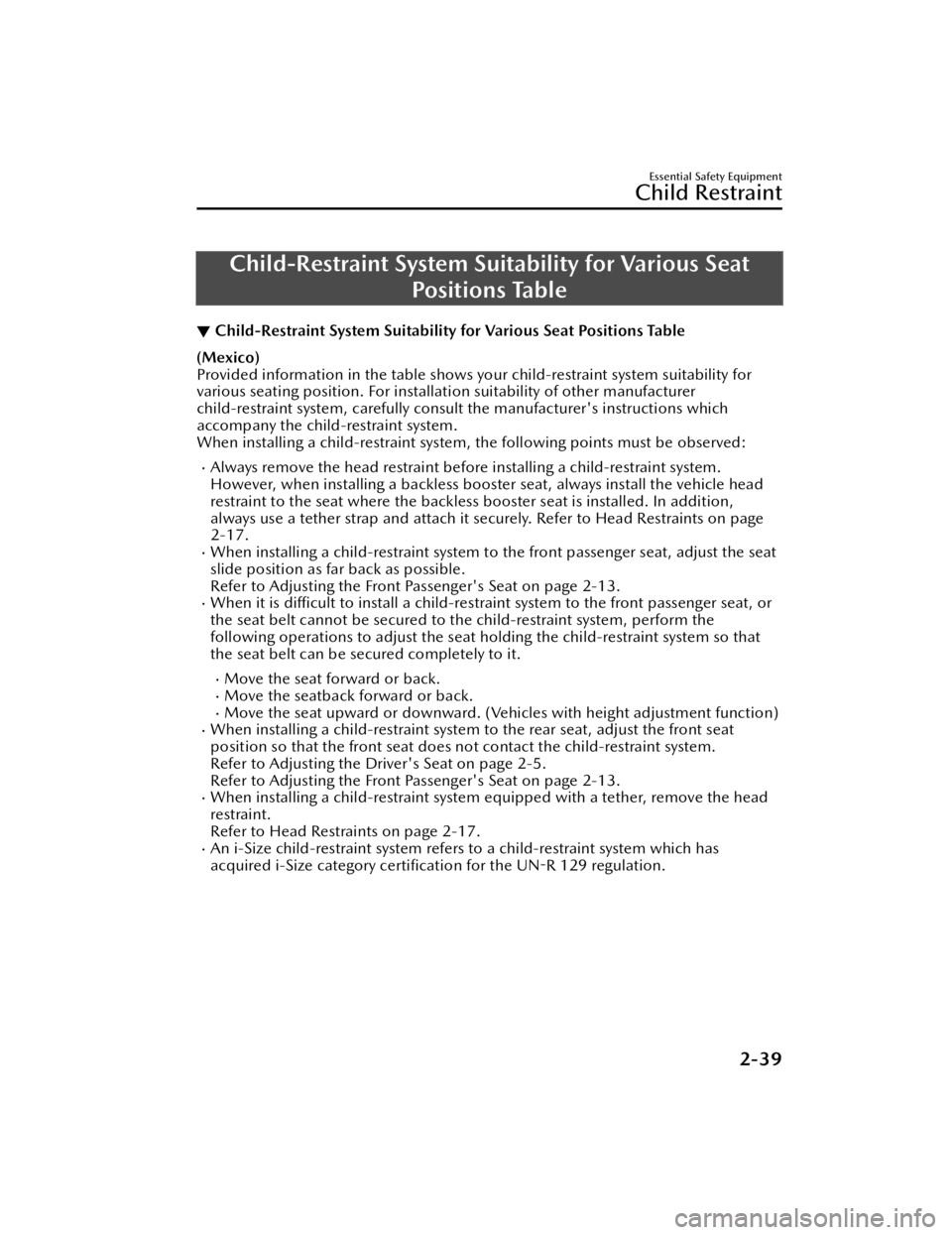
Child-Restraint System Suitability for Various SeatPo s i t i o n s Ta b l e
▼Child-Restraint System Suitability
for Various Seat Positions Table
(Mexico)
Provided information in the table shows your child-restraint system suitability for
various seating position. For installation suitability of other manufacturer
child-restraint system, carefully consult the manufacturer's instructions which
accompany the child-restraint system.
When installing a child-re straint system, the following points must be observed:
Always remove the head restraint before installing a child-restraint system.
However, when installing a backless booster seat, always install the vehicle head
restraint to the seat where the backless b ooster seat is installed. In addition,
always use a tether strap and attach it securely. Refer to Head Restraints on page
2-17.
When installing a child-restraint system to the front passenger seat, adjust the seat
slide position as far back as possible.
Refer to Adjusting the Front Passenger's Seat on page 2-13.
When it is di fficult to install a child-restraint sy stem to the front passenger seat, or
the seat belt cannot be secured to th e child-restraint system, perform the
following operations to adjust the seat ho lding the child-restraint system so that
the seat belt can be secured completely to it.
Move the seat forward or back.Move the seatback forward or back.Move the seat upward or downward. (Veh icles with height adjustment function)When installing a child-restraint system to the rear seat, adjust the front seat
position so that the front seat does not contact the child-restraint system.
Refer to Adjusting the Driver's Seat on page 2-5.
Refer to Adjusting the Front Passenger's Seat on page 2-13.
When installing a child-restraint system equipped with a tether, remove the head
restraint.
Refer to Head Restraints on page 2-17.
An i-Size child-restraint system refers to a child-restraint system which has
acquired i-Size category certi fication for the UN-R 129 regulation.
Essential Safety Equipment
Child Restraint
2-39
Mazda3_8JM2-EA -20H_Edition1_new 2020-7-10 17:21:34
Page 55 of 612

Seating position Passenger Rear (Left) Rear (Center) Rear (Right)
Non i-size compat-
ible with a support
leg (Yes/No) Ye s
*1Ye s
N oYe s
Lower ISOFIX an-
chorages but with-
out Top Tether
(Yes/No) No
NoNo No
U = Suitable for “universal” category restraints approved for use in this mass group.
UF = Suitable for forward-facing “universal” category restraints approved for use in this mass group.
IUF = Suitable for ISOFIX forward child restraints systems of universal category approved for use in the
mass group.
L = Suitable for particular child restraints given on attached list. These restraints may be of the
“s p e c ific
vehicle”, “restricted” or “semi-universal” categories.
IL = Suitable for particular ISOFIX child restraint syst ems (CRS) given in the attached list. These ISOFIX CRS
are those of the “speci fic vehicle”, “restricted” or “semi-universal” categories.
i-U = Suitable for i-Size “universal” Child Restraint Systems forward and rearward facing.
i-UF = Suitable for forward-facing i-Size “universal” Child Restraint Systems only.
Yes = Child-restraint system can be secured on the seat.
No = Child-restraint system cannot be secured on the seat, or there is no fixture.
X = Child-restraint system cannot be installed.
*1 Child restraint system can only be installed in the forward-facing position.
A Mazda genuine child-restraint system can be installed. Regarding child-restraint systems which can be
installed, refer to the accessories catalog.
(Except Mexico)
Regarding child-restraint syst ems which can be installed to your Mazda, consult an
Authorized Mazda Dealer.
A child-restraint system with a support le g cannot be installed on the rear center
seat position.
Please comply with the legal regulations concerning the use of child-restraint
systems in your country.
For the CRS which do not carry the ISO/XX size class identi fication (A to G), for
the applicable mass group, the child seat manufacturer shall indicate the vehicle
specific LATCH child-restraint systems recommended for each position.
Essential Safety Equipment
Child Restraint
2-41
Mazda3_8JM2-EA -20H_Edition1_new 2020-7-10 17:21:34
Page 56 of 612

Installing Child-RestraintSystems
▼Installing Child-Restraint Systems
Accident statistics reveal that a child is
safer in the rear seat. The front
passenger's seat is clearly the worst
choice for any child under 12, and
with rear-facing child-restraint systems
it is clearly unsafe due to air bags.
NOTE
Even if your vehicle is equipped with
front passenger occupant classi
fication
sensor (page 2-71), which
automatically deactivates the front
passenger air bag , a rear seat is the
safest place for a child of any age or
size.
Some child-restraint systems now
come with tethers and therefore must
be installed on the seats that take
tethers to be e ffective. In your Mazda,
tethered child-restraint systems can
only be accommodated in the three
positions on the rear seat.
Some child-restraint systems also
employ specially designed ISOFIX/
LATCH
*1 attachments; refer to "Using
ISOFIX Lower Anchor (Mexico)/Using
LATCH Lower Anchor (Except
Mexico)" (page 2-50).
*1 ISOFIX (Mexico)/LATCH (Except Mexico)
WARNING
Tethered Child-Restraint Systems
Work Only on Tether-Equipped Rear
Seats:
Installation of a tether equipped
child-restraint system in the front
passenger's seat defeats the safety
design of the system and will result in
an increased chance of serious injury if
the child-restraint system goes forward
without benefit of being tethered.
Place tether equipped child-restraint
systems where there are tether
anchors.
▼ Anchor Bracket
Anchor brackets for securing
child-restraint systems are equipped in
the vehicle. Locate each anchor
position using the illustration.
To install a child-restraint system,
remove the head restraint. Always
follow the instruction manual
accompanying the child-restraint
system.
Anchor bracket location
Use the indicated anchor bracket
locations when installing a
child-restraint system equipped with a
tether.
(4–Door)
1. For right
2. For center (Except Mexico)
3. For left
Essential Safety Equipment
Child Restraint
2-42
Mazda3_8JM2-EA
-20H_Edition1_new 2020-7-10 17:21:34
Page 58 of 612

(5–Door)
1. Tether strap
2. Anchor bracket
3. Forward
Always install the head restraint and
adjust it to the appropriate position
after removing the child-restraint
system:
Driving with the head restraint
removed is dangerous as impact to the
occupant's head cannot be prevented
during emergency braking or in a
collision, which could result in a
serious accident, injury or death.
Refer to Head Restraints on page 2-17.
▼Using Automatic Locking Mode
(Except Mexico)
Follow these instructions when using a
child-restraint system, unless you are
attaching a LATCH
-equipped
child-restraint system to the rear
LATCH lower anchors. Refer to “Using
LATCH Lower Anchor” (page 2-50).
NOTE
Follow the child-restraint system
manufacturer's instructions carefully. If
you are not sure whether you have a
LATCH system or tether, check in the
child-restraint system manufacturer's
instructions and follow them
accordingly. Depending on the type of
child-restraint system, it may use
LATCH system instead of seat belts or if
the belt goes across the child's chest,
may recommend against using
automatic locking mode.
1. Make sure the seatback is securely latched by pushing it back until it is
fully locked.
2. Remove the head restraint. However, when installing a backless
booster seat, always install the
vehicle head restraint to the seat
where the backless booster seat is
installed.
Refer to Head Restraints on page
2-17.
3. Secure the child-restraint system with the lap portion of the lap/
shoulder belt. See the
manufacturer's instructions on the
child-restraint system for belt
routing instructions.
Essential Safety Equipment
Child Restraint
2-44
Mazda3_8JM2-EA -20H_Edition1_new 2020-7-10 17:21:34
Page 59 of 612
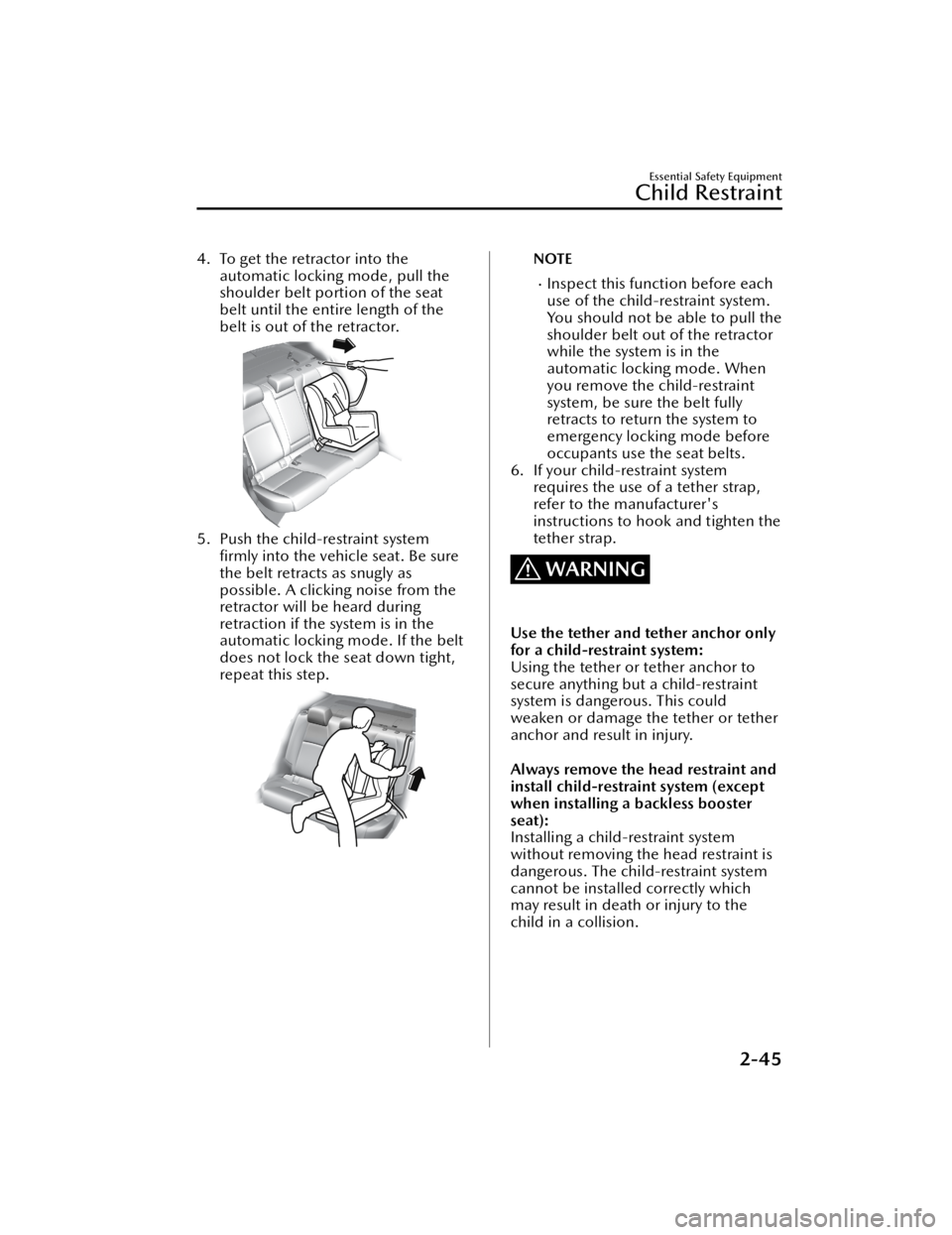
4. To get the retractor into theautomatic locking mode, pull the
shoulder belt portion of the seat
belt until the entire length of the
belt is out of the retractor.
5. Push the child-restraint system
firmly into the vehicle seat. Be sure
the belt retracts as snugly as
possible. A clicking noise from the
retractor will be heard during
retraction if the system is in the
automatic locking mode. If the belt
does not lock the seat down tight,
repeat this step.
NOTE
Inspect this function before each
use of the child-restraint system.
You should not be able to pull the
shoulder belt out of the retractor
while the system is in the
automatic locking mode. When
you remove the child-restraint
system, be sure the belt fully
retracts to return the system to
emergency locking mode before
occupants use the seat belts.
6. If your child-restraint system requires the use of a tether strap,
refer to the manufacturer's
instructions to hook and tighten the
tether strap.
WARNING
Use the tether and tether anchor only
for a child-restraint system:
Using the tether or tether anchor to
secure anything but a child-restraint
system is dangerous. This could
weaken or damage the tether or tether
anchor and result in injury.
Always remove the head restraint and
install child-restraint system (except
when installing a backless booster
seat):
Installing a child-restraint system
without removing the head restraint is
dangerous. The child-restraint system
cannot be installed correctly which
may result in death or injury to the
child in a collision.
Essential Safety Equipment
Child Restraint
2-45
Mazda3_8JM2-EA -20H_Edition1_new 2020-7-10 17:21:34
Page 61 of 612
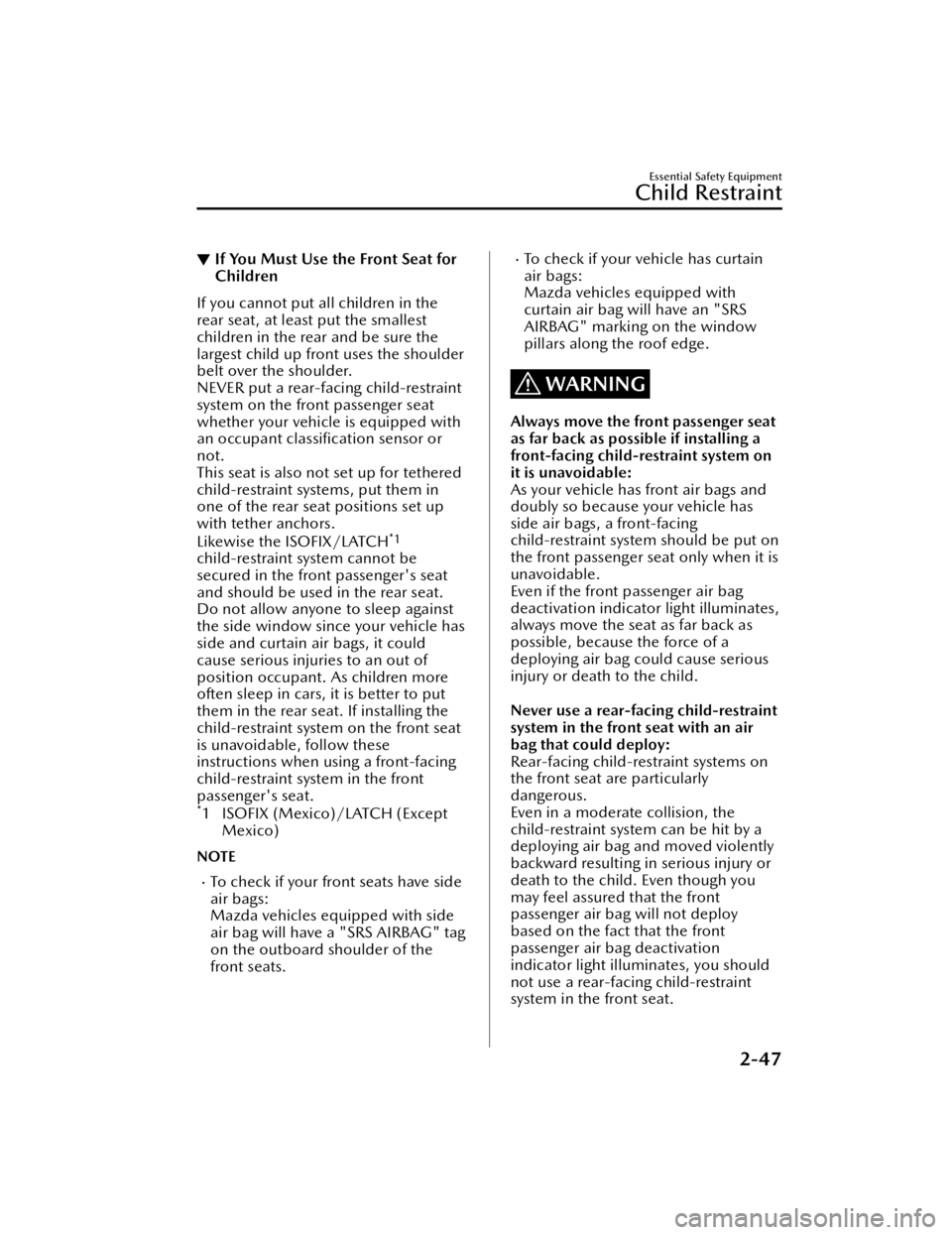
▼If You Must Use the Front Seat for
Children
If you cannot put all children in the
rear seat, at least put the smallest
children in the rear and be sure the
largest child up front uses the shoulder
belt over the shoulder.
NEVER put a rear-facing child-restraint
system on the front passenger seat
whether your vehicle is equipped with
an occupant classi
fication sensor or
not.
This seat is also not set up for tethered
child-restraint systems, put them in
one of the rear seat positions set up
with tether anchors.
Likewise the ISOFIX/LATCH
*1
child-restraint system cannot be
secured in the front passenger's seat
and should be used in the rear seat.
Do not allow anyone to sleep against
the side window since your vehicle has
side and curtain air bags, it could
cause serious injuries to an out of
position occupant. As children more
often sleep in cars, it is better to put
them in the rear seat. If installing the
child-restraint system on the front seat
is unavoidable, follow these
instructions when using a front-facing
child-restraint system in the front
passenger's seat.
*1 ISOFIX (Mexico)/LATCH (Except Mexico)
NOTE
To check if your front seats have side
air bags:
Mazda vehicles equipped with side
air bag will have a "SRS AIRBAG" tag
on the outboard shoulder of the
front seats.
To check if your vehicle has curtain
air bags:
Mazda vehicles equipped with
curtain air bag will have an "SRS
AIRBAG" marking on the window
pillars along the roof edge.
WARNING
Always move the front passenger seat
as far back as possible if installing a
front-facing child-restraint system on
it is unavoidable:
As your vehicle has front air bags and
doubly so because your vehicle has
side air bags, a front-facing
child-restraint system should be put on
the front passenger seat only when it is
unavoidable.
Even if the front passenger air bag
deactivation indicator light illuminates,
always move the seat as far back as
possible, because the force of a
deploying air bag could cause serious
injury or death to the child.
Never use a rear-facing child-restraint
system in the front seat with an air
bag that could deploy:
Rear-facing child-restraint systems on
the front seat are particularly
dangerous.
Even in a moderate collision, the
child-restraint system can be hit by a
deploying air bag and moved violently
backward resulting in serious injury or
death to the child. Even though you
may feel assured that the front
passenger air bag will not deploy
based on the fact that the front
passenger air bag deactivation
indicator light illuminates, you should
not use a rear-facing child-restraint
system in the front seat.
Essential Safety Equipment
Child Restraint
2-47
Mazda3_8JM2-EA -20H_Edition1_new 2020-7-10 17:21:34
Page 63 of 612
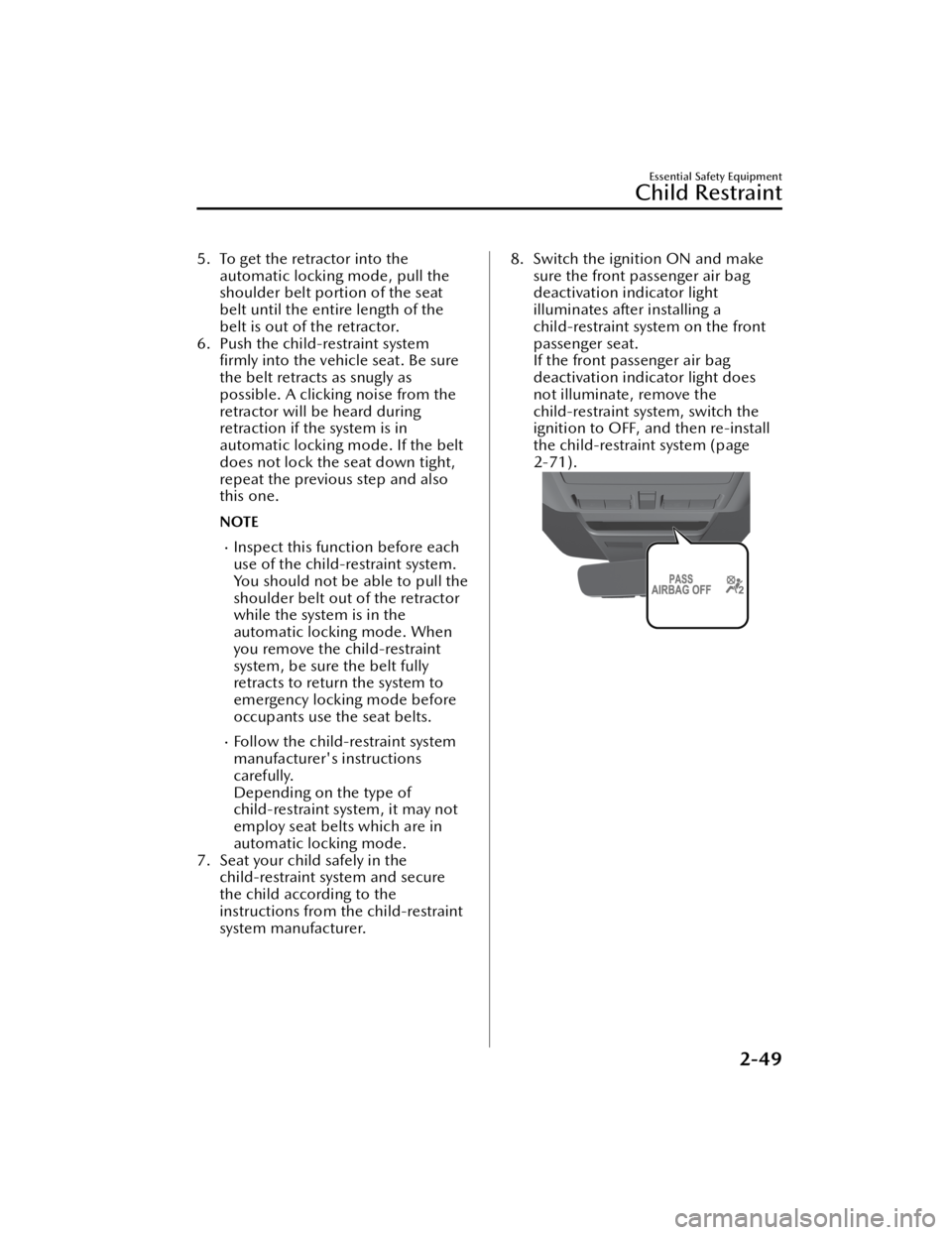
5. To get the retractor into theautomatic locking mode, pull the
shoulder belt portion of the seat
belt until the entire length of the
belt is out of the retractor.
6. Push the child-restraint system firmly into the vehicle seat. Be sure
the belt retracts as snugly as
possible. A clicking noise from the
retractor will be heard during
retraction if the system is in
automatic locking mode. If the belt
does not lock the seat down tight,
repeat the previous step and also
this one.
NOTE
Inspect this function before each
use of the child-restraint system.
You should not be able to pull the
shoulder belt out of the retractor
while the system is in the
automatic locking mode. When
you remove the child-restraint
system, be sure the belt fully
retracts to return the system to
emergency locking mode before
occupants use the seat belts.
Follow the child-restraint system
manufacturer's instructions
carefully.
Depending on the type of
child-restraint system, it may not
employ seat belts which are in
automatic locking mode.
7. Seat your child safely in the child-restraint system and secure
the child according to the
instructions from the child-restraint
system manufacturer.
8. Switch the ignition ON and makesure the front passenger air bag
deactivation indicator light
illuminates after installing a
child-restraint system on the front
passenger seat.
If the front passenger air bag
deactivation indicator light does
not illuminate, remove the
child-restraint system, switch the
ignition to OFF, and then re-install
the child-restraint system (page
2-71).
Essential Safety Equipment
Child Restraint
2-49
Mazda3_8JM2-EA -20H_Edition1_new 2020-7-10 17:21:34
Page 64 of 612
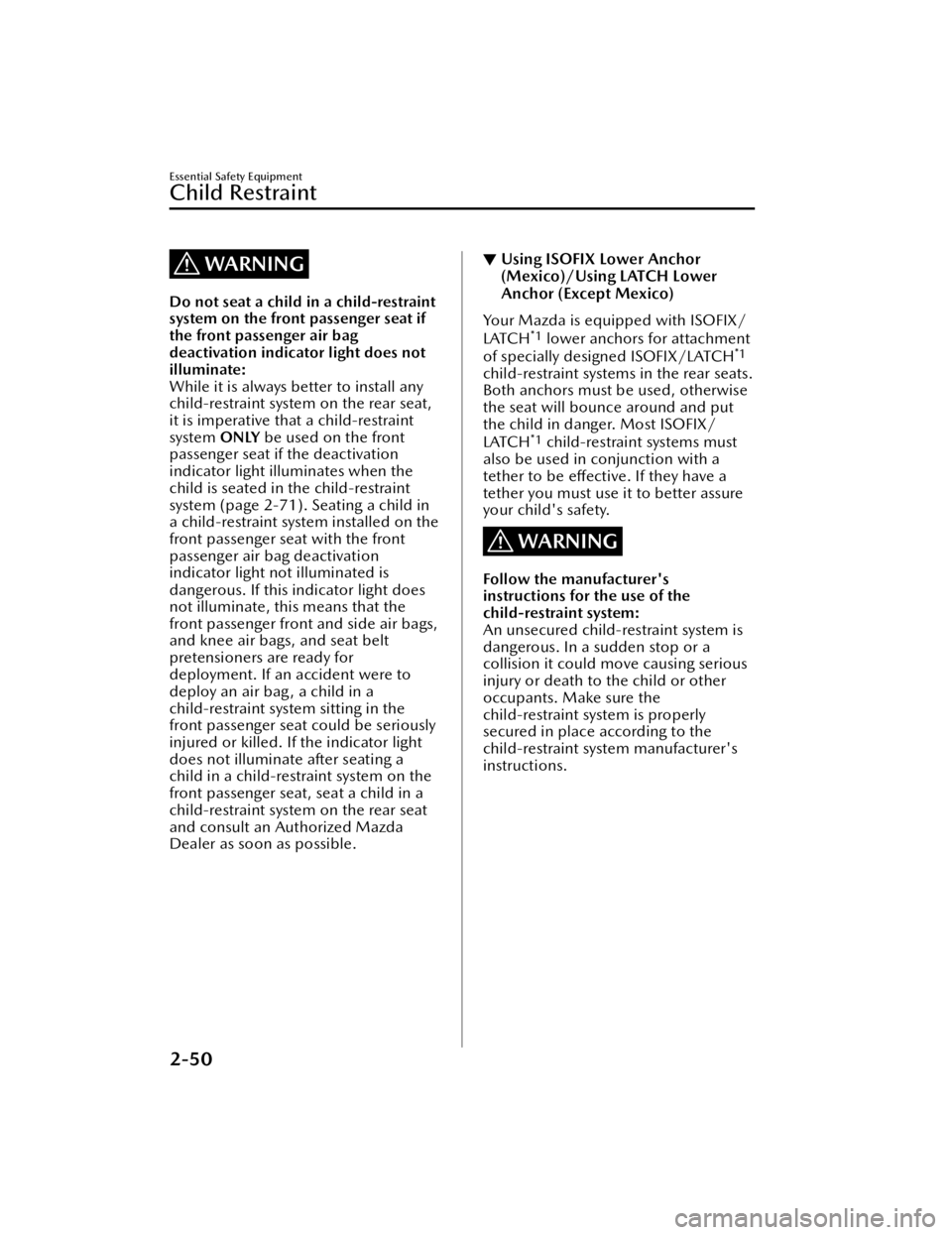
WARNING
Do not seat a child in a child-restraint
system on the front passenger seat if
the front passenger air bag
deactivation indicator light does not
illuminate:
While it is always better to install any
child-restraint system on the rear seat,
it is imperative that a child-restraint
system ONLY be used on the front
passenger seat if the deactivation
indicator light illuminates when the
child is seated in the child-restraint
system (page 2-71). Seating a child in
a child-restraint system installed on the
front passenger seat with the front
passenger air bag deactivation
indicator light not illuminated is
dangerous. If this indicator light does
not illuminate, this means that the
front passenger front and side air bags,
and knee air bags, and seat belt
pretensioners are ready for
deployment. If an accident were to
deploy an air bag, a child in a
child-restraint system sitting in the
front passenger seat could be seriously
injured or killed. If the indicator light
does not illuminate after seating a
child in a child-restraint system on the
front passenger seat, seat a child in a
child-restraint system on the rear seat
and consult an Authorized Mazda
Dealer as soon as possible.
▼ Using ISOFIX Lower Anchor
(Mexico)/Using LATCH Lower
Anchor (Except Mexico)
Your Mazda is equipped with ISOFIX/
LATCH*1 lower anchors for attachment
of specially designed ISOFIX/LATCH*1
child-restraint systems in the rear seats.
Both anchors must be used, otherwise
the seat will bounce around and put
the child in danger. Most ISOFIX/
LATCH
*1 child-restraint systems must
also be used in conjunction with a
tether to be e ffective. If they have a
tether you must use it to better assure
your child's safety.
WARNING
Follow the manufacturer's
instructions for the use of the
child-restraint system:
An unsecured child-restraint system is
dangerous. In a sudden stop or a
collision it could move causing serious
injury or death to the child or other
occupants. Make sure the
child-restraint system is properly
secured in place according to the
child-restraint system manufacturer's
instructions.
Essential Safety Equipment
Child Restraint
2-50
Mazda3_8JM2-EA -20H_Edition1_new 2020-7-10 17:21:34